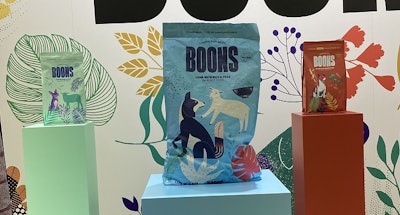
Interzoo is back! The largest global pet trade show happened May 24-27 as an in-person event for the first time in four years. And everyone there, including yours truly, seemed very happy about it: The many halls were buzzing with activity, conversation and business. I heard a few comments that the number of stands and attendees did not quite reach 2018 levels, but considering that we’ve all been through a two-year-long (and counting) pandemic, I found the attendance and dynamic very reassuring. (And Interzoo organizers seemed very pleased.)
Similarly, Petfood Forum Europe 2022, held on May 23 just before Interzoo began, was well attended; in fact, its 250 attendees was the highest number ever. (Note: The conference is owned and organized by Petfood Industry and Watt Global Media.) And, as with Interzoo, everyone participating seemed very glad to be there and joining in an in-person event again.
What was not back—because it never ended or went away—was the pet food market’s strength. The industry’s ongoing growth has been a very bright silver lining to the COVID-19 cloud, and both Petfood Forum Europe and Interzoo provided signs that it’s continuing to shine.
Spending levels holding steady, growing in most markets
Kate Vlietstra, associate director for Mintel Food and Drink, opened Petfood Forum Europe with a look at the current state and future of the pet food market. Showing data on per capita retail spending on pets, she commented that American pet owners outspend those in Europe, but some European markets have greater compound annual growth rates (CAGR). Those include Norway and Spain, projected to grow between 3 and 4% over the next five years, and Poland, the “standout opportunity” with a projected 8% CAGR.
Globally, markets in Asia like Thailand, India and China are expected to grow about 15% through 2027, while ones in South and Central America—Brazil, Columbia and the Philippines—project at 8 to 10% CAGR. These data track with pre-pandemic projections, indicating the resilience and continuing strength of pet food globally. Indeed, during an Interzoo 2022 country session on Brazil, speakers presented Euromonitor data showing that overall pet care sales in the country increased nearly 100% (99%) from 2016 to 2021, and are projected to soar another 146% by 2026. That compares to global growth rates of 42% and 24%, respectively.
Pet food trends: Sustainability, fun graphics
Before Interzoo, I speculated about the trends I might see there, wondering if ones dominating at shows like Global Pet Expo 2022 would be on display in Germany, too. Those included pet treats with collagen, treats and foods with other functional ingredients and “alternative” pet food formats such as freeze-dried and air-dried. While all those made an appearance at Interzoo, particularly functionality, another trend I previously wrote about dominated in Germany: sustainability.
Actually, it’s no longer a trend, in my opinion, as pet food manufacturers and suppliers recognize how important it has become to consumers and to their businesses’ performance. For example, in another Interzoo session on Western Europe, Aleksandras Bacevicius, research analyst, food and nutrition, for Euromonitor, shared data indicating pet owners’ growing interest in sustainability.
A survey of Europeans showed about 65% of pet owners are worried about climate change and try to have a positive impact on the environment through their everyday actions, while 30% said they try to buy sustainably produced items. Globally, the percentage of pet owners reducing their meat consumption to positively impact the environment ranges from about 23% in North America to about 33% in Latin America.
That more pet food and pet product companies are touting their sustainability bona fides is good news; according to Vlietstra, pet food is lagging behind human food when it comes to such claims. At Interzoo, I saw not only package claims but marketing and graphics such as “Happy dogs, happy planet” and “Good for your dog and for our planet.”
The latter was a slogan for a brand named accordingly: Green Dog Co. And its packaging resembled many other pet food and treat packages I couldn’t help noticing because of their graphics comprised of fun, whimsical, colorful illustrations. In the new products area of Interzoo and in stands throughout the show, I took numerous photos of such graphics. It’s difficult to say if this is a trend or perhaps just a reflection of how people and companies are reacting to emerging from the dark period of the past two years?
Bugs, bugs everywhere
If pet food sustainability messages and claims were everywhere at Interzoo, companies offering insect protein-based diets and treats (or the protein ingredients) weren’t far behind. With insect protein being approved for inclusion in pet foods and animal feed in Europe, as well as Asia, for a few years now, it’s not necessarily surprising to see more at a global show held in Europe compared to one in North America, where regulatory approval is just starting to take hold. Still, the sheer number on display at Interzoo was noticeable.
Indeed, Petfood Forum Europe included presentations on mealworms and black soldier fly larvae; both species of insects were well represented at Interzoo stands, along with crickets and even silkworms. The latter were offered as protein ingredients in the form of meal and oil by a startup, Prombyx, based in Germany and sourcing from India. Its founder and CEO, Fabiola Neitzel, explained the process for harvesting silkworm protein during a presentation on Interzoo’s Fresh Ideas stage, which showcased startup companies. (Prombyx also won an innovation award among the Fresh Ideas presenters.)
Insect protein ties in well to sustainability, especially compared to traditional animal-based pet food ingredients. In addition, it’s gaining acceptance among consumers: Vlietstra reported in her Petfood Forum Europe presentation that 36% of U.K. pet food buyers now say they would be interested in foods with insect protein, up from 21% in only three years.
Similarly, during Petfood Forum 2022 in the U.S. on May 3, Brad Ewankiw, product line manager, feed, for Enterra, presented survey data showing that 55% of North American pet owners were very or somewhat interested in purchasing pet diets with insect protein after receiving a brief education about it (compared to 42% pre-education), versus 36% and 23%, respectively, in 2020.
While Vlietstra acknowledged that insect protein claims account for less than 1% of global pet food product launches, the growing interest and number of suppliers and products entering the category likely mean that percentage is poised to grow.


















